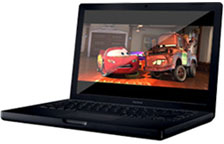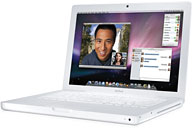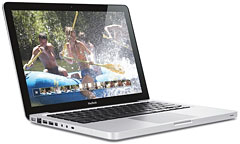Mac Musings
The MacBook Legacy: 2006 to 2011
Dan Knight - 2012.05.16 - Tip Jar
On May 16, 2006, Apple introduced the consumer MacBook, the 13.3" replacement for the old 12" and 14" iBooks. The MacBooks had a wider 1280 x 800 display (vs. 1024 x 768 for G4 iBooks) and used Intel's Core Duo processors. The biggest differences between the consumer MacBook and the MacBook Pro are the MacBook's polycarbonate body and lack of a FireWire port.
The consumer MacBook was an immediate hit, and Apple continued to offer these polycarbonate notebooks until July 2011, when the last one was discontinued in favor of the 11.6" and 13.3" MacBook Air. Although the regular MacBook has been discontinued (the only model of Apple's Intel era discontinued to date), its legacy lives on in the 13.3" MacBook Pro.
The Original (May 2006)
Measuring 12.78" x 8.92" x 1.08" and weighing 5.2 lb., its widescreen display meant it was wider and a bit heavier than the 12" iBook G4 it replaced (11.3" x 9.06" x 1.35", 4.9 lb.) yet thinner and not as deep. The size and weight of the polycarbonate MacBook would remain pretty much identical through the model's entire run.
 The first generation MacBooks ran at
1.83 GHz and 2.0 GHz speeds with prices starting at $1,099. They
support up to 2 GB of system memory, and because the Core Duo
processor does not operate in 64-bit mode, they are unable to run
Mac OS X 10.7 Lion or
later. The integrated Intel GMA 950 graphics are adequate for regular
use, but not up to supporting 3D gaming at high frame rates.
The first generation MacBooks ran at
1.83 GHz and 2.0 GHz speeds with prices starting at $1,099. They
support up to 2 GB of system memory, and because the Core Duo
processor does not operate in 64-bit mode, they are unable to run
Mac OS X 10.7 Lion or
later. The integrated Intel GMA 950 graphics are adequate for regular
use, but not up to supporting 3D gaming at high frame rates.
It's hard to imagine today, but the entry-level 1.83 GHz and white 2.0 GHz MacBooks came with just 512 MB of memory, which was barely adequate to run Mac OS X 10.4.6 Tiger, the version of OS X that originally shipped with this model. The top-end black 2.0 GHz model shipped with 1 GB of memory, which made it a much better performer.
These can be great field computers for those using who don't need to run OS X 10.7 Lion, especially if you upgrade memory to 2 GB.
Core 2 Duo (Nov. 2006)
Six months later, Apple move the MacBook to Intel's newer Core 2 Duo processor, which is approximately 7% more powerful and also supports 64-bit operation, making this the first consumer MacBook able to run OS X 10.7 Lion. Other than the CPU, prices and configurations were identical to the Core Duo model.
An additional benefit of the Core 2 Duo processor is that these Macs can run up to 3 GB of memory, which is a real plus with OS X 10.6 Snow Leopard and later. For Lion, you should upgrade to maximum system memory.
Speed Bump (May 2007)
And six months after that, Apple increased CPU speeds to 2.0 GHz and 2.16 GHz and made 1 GB of memory standard across the board.
Santa Rosa (Oct. 2007)
The MacBook received a significant upgrade under the hood with the Late 2007 model. They used Intel's Santa Rosa CPU at 2.0 and 2.2 GHz on an 800 MHz system bus, up from 667 MHz on earlier MacBooks, and they support up to 6 GB of memory, which further unleashes them. These were the first MacBooks to ship with OS X 10.5 Leopard, and their integrated Intel X3100 graphics was a big step forward from the GMA 950 used in previous MacBooks.
Penryn (Feb. 2008)
The next generation MacBook was another small speed bump. The entry-level MacBook went from 2.0 to 2.1 GHz, and the faster model from 2.2 to 2.4 GHz, which is the highest clock speed any MacBook ever had.
 Except for the faster
processors, these are almost identical to the October 2007 revision -
and prices are the same $1,099, $1,299, and $1,499 of the original
MacBook and each subsequent model. This was the last MacBook model
available in black.
Except for the faster
processors, these are almost identical to the October 2007 revision -
and prices are the same $1,099, $1,299, and $1,499 of the original
MacBook and each subsequent model. This was the last MacBook model
available in black.
MacBook White (Oct. 2008)
In Late 2008, Apple simplified the polycarbonate MacBook line by paring it down to a single 2.1 GHz model - and trimming the retail price to $999. This model is virtually identical to the 2.1 GHz Early 2008 model.
Aluminum Unibody (Oct. 2008)
Apple took a different direction in Late 2008 by releasing a unibody
MacBook crafted from a block of aluminum,  the same technology used in the
MacBook Air and the Late 2008 MacBook Pro.
The aluminum unibody construction made this model a bit smaller, a bit
more solid, and a half-pound lighter.
the same technology used in the
MacBook Air and the Late 2008 MacBook Pro.
The aluminum unibody construction made this model a bit smaller, a bit
more solid, and a half-pound lighter.
This was the first MacBook to use a dedicated graphics processor. The Nvidia GeForce 9400M was a big step forward, but the Aluminum MacBook was also a premium model - $1,299 for the 2.0 GHz model and $1,599 for the 2.4 GHz. This was the first MacBook with a 1066 MHz system bus and will probably be the oldest MacBook to support OS X 10.8 Mountain Lion.
Apple basically took this design, added FireWire, and created the 13.3" MacBook Pro in June 2009.
Nvidia (Jan. 2009)
The regular MacBook took a big step forward in the graphics department with the Early 2009 model, which included a dedicated Nvidia GeForce 9400M graphics processor, yet at the same time trimming clock speed back to 2.0 GHz. Apple increased the system bus from 800 MHz to 1066 MHz, which also improves performance, and it has the same 6 GB memory ceiling as all models since Late 2007.
If you're at all into 3D gaming, this is the oldest MacBook that will really satisfy you, and it's very likely that this is the oldest polycarbonate MacBook that will be supported when OS X 10.8 Mountain Lion ships later this year. (Apple has not made any official pronouncements, but this is the oldest model supported by the Developer Preview.)
Nvidia (May 2009)
Yet another incremental speed bump, this 2.13 GHz model (twice as fast as the 1066 MHz system bus) was just a bit faster than the Late 2008 model - but with the added advantage of a real graphics processor.
Nvidia (Oct. 2009)
The Late 2009 MacBook bumped speed to 2.26 GHz and raised the memory ceiling to 8 GB. This was the first MacBook to ship with OS X 10.6 Snow Leopard.
GeForce 320M (June 2010)
The last of the polycarbonate MacBooks moved to Nvidia GeForce 320M graphics and brought back the MacBook's highest clock speed - 2.4 GHz. The Mid 2010 MacBook offers the best graphics performance of the entire MacBook series. Coupled with the highest clock speed, this is the ultimate MacBook in terms of performance.
The MacBook Legacy
Until Apple introduced the 11.6" MacBook Air, the consumer MacBook was the most affordable Mac notebook, and it always provided good value for the price. It lacked the ExpressCard, FireWire, and SD Card slots found in most MacBook Pro models, but the typical low-end user was satisfied with USB 2.0 connectivity.
The polycarbonate case had its share of teething problems, especially cracks developing, but Apple improved it over time, and the models with Nvidia graphics should make great machines for gaming, watching high-def video, and use with an external monitor or 1080p TV set.
If you use legacy software from the PowerPC era, you'll probably want to run Mac OS X 10.6 Snow Leopard, which is fully optimized for Intel processors and still included the Rosetta software that lets you use those legacy apps. I would want 2 GB of memory as a minimum with Snow Leopard, which runs on all MacBooks.
Only the first generation of MacBooks - those with Core Duo CPUs - is unable to run OS X 10.7 Lion, so you have a lot of options there. Again, having enough memory is going to be the key to good performance, and you'll probably find 3-4 GB does the job.
If you plan on running OS X 10.8 Mountain Lion on a MacBook, look at the models with Nvidia graphics. It is almost a certainty that the MacBooks with integrated Intel graphics will not support Mountain Lion. I'm guessing 4 GB of memory is going to be a minimum for decent performance.
Beyond Mountain Lion, who knows.
You can pick up a nice used MacBook from a dealer starting at about $400, so if you're looking for a low-cost Intel Mac for use in the field, this is probably the way to go.
Join us on Facebook, follow us on Twitter or Google+, or subscribe to our RSS news feed
Dan Knight has been using Macs since 1986, sold Macs for several years, supported them for many more years, and has been publishing Low End Mac since April 1997. If you find Dan's articles helpful, please consider making a donation to his tip jar.
Links for the Day
- Mac of the Day: Motorola StarMax 5000, introduced 1997.04. This second-generation Mac clone offered 603e, 604e processors.
- Support Low End Mac
Recent Content
About LEM Support Usage Privacy Contact
Follow Low End Mac on Twitter
Join Low End Mac on Facebook
Favorite Sites
MacSurfer
Cult of Mac
Shrine of Apple
MacInTouch
MyAppleMenu
InfoMac
The Mac Observer
Accelerate Your Mac
RetroMacCast
The Vintage Mac Museum
Deal Brothers
DealMac
Mac2Sell
Mac Driver Museum
JAG's House
System 6 Heaven
System 7 Today
the pickle's Low-End Mac FAQ
Affiliates
Amazon.com
The iTunes Store
PC Connection Express
Macgo Blu-ray Player
Parallels Desktop for Mac
eBay

